Safe Competent Practice: A Critique of IV Drug Administration Methods
VerifiedAdded on 2022/07/28
|8
|2238
|56
Report
AI Summary
This report critically examines the safe and competent practices of intravenous (IV) drug administration, focusing on IV bolus and intermittent infusion techniques. The analysis is based on observations from three videos showcasing nurses performing these procedures. The report highlights the importance of hand hygiene, patient assessment, medication verification, and adherence to patient autonomy. It identifies both correct procedures and errors, such as failures to obtain informed consent, omissions in medication safety checks (e.g., the five rights), and improper waste disposal. The reflection emphasizes the need for nurses to prioritize hygiene, proper waste management, and consistent adherence to established protocols to ensure patient safety and quality care. The report underscores that continuous learning and the implementation of best practices are crucial for preventing errors and improving patient outcomes in healthcare settings.
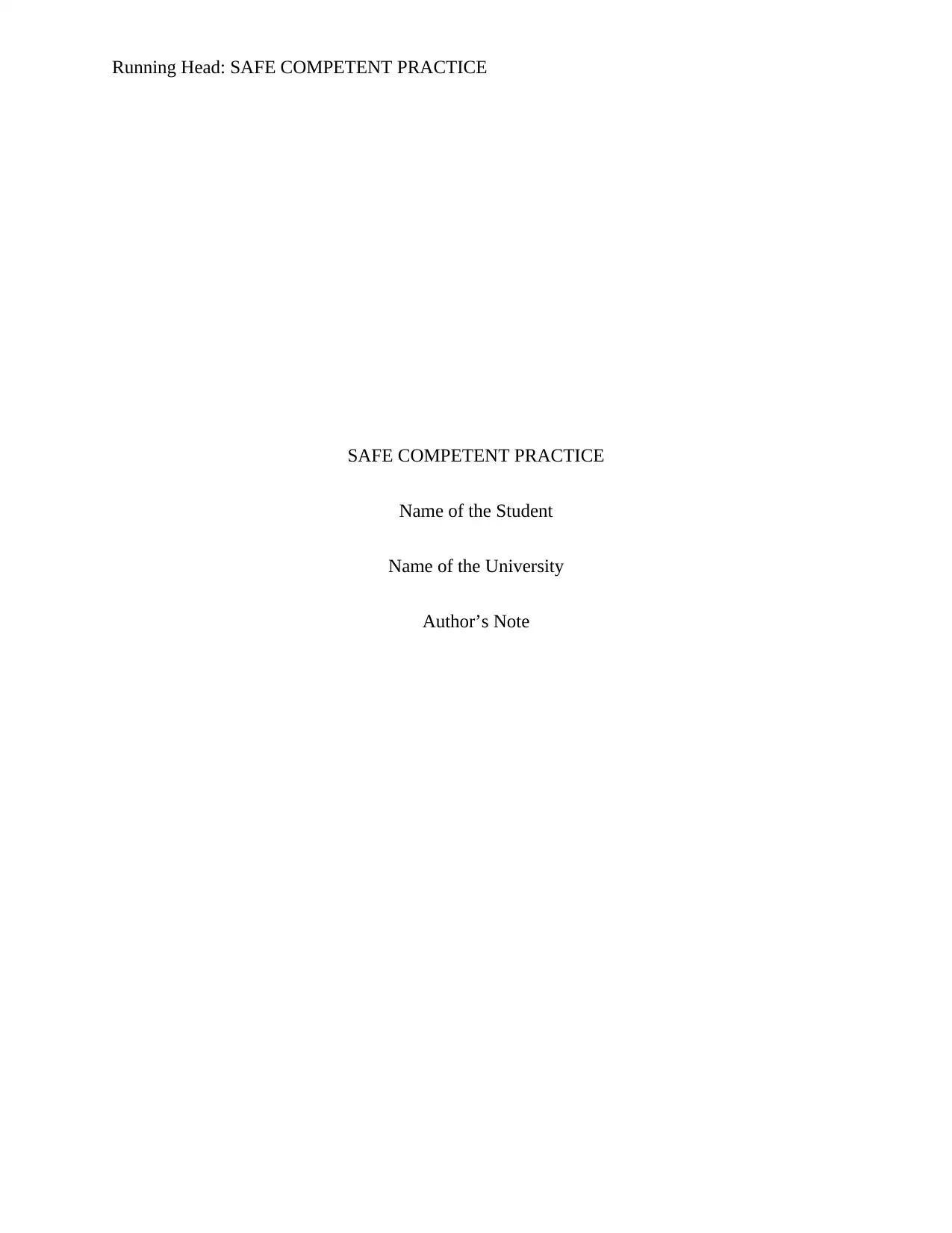
Running Head: SAFE COMPETENT PRACTICE
SAFE COMPETENT PRACTICE
Name of the Student
Name of the University
Author’s Note
SAFE COMPETENT PRACTICE
Name of the Student
Name of the University
Author’s Note
Paraphrase This Document
Need a fresh take? Get an instant paraphrase of this document with our AI Paraphraser
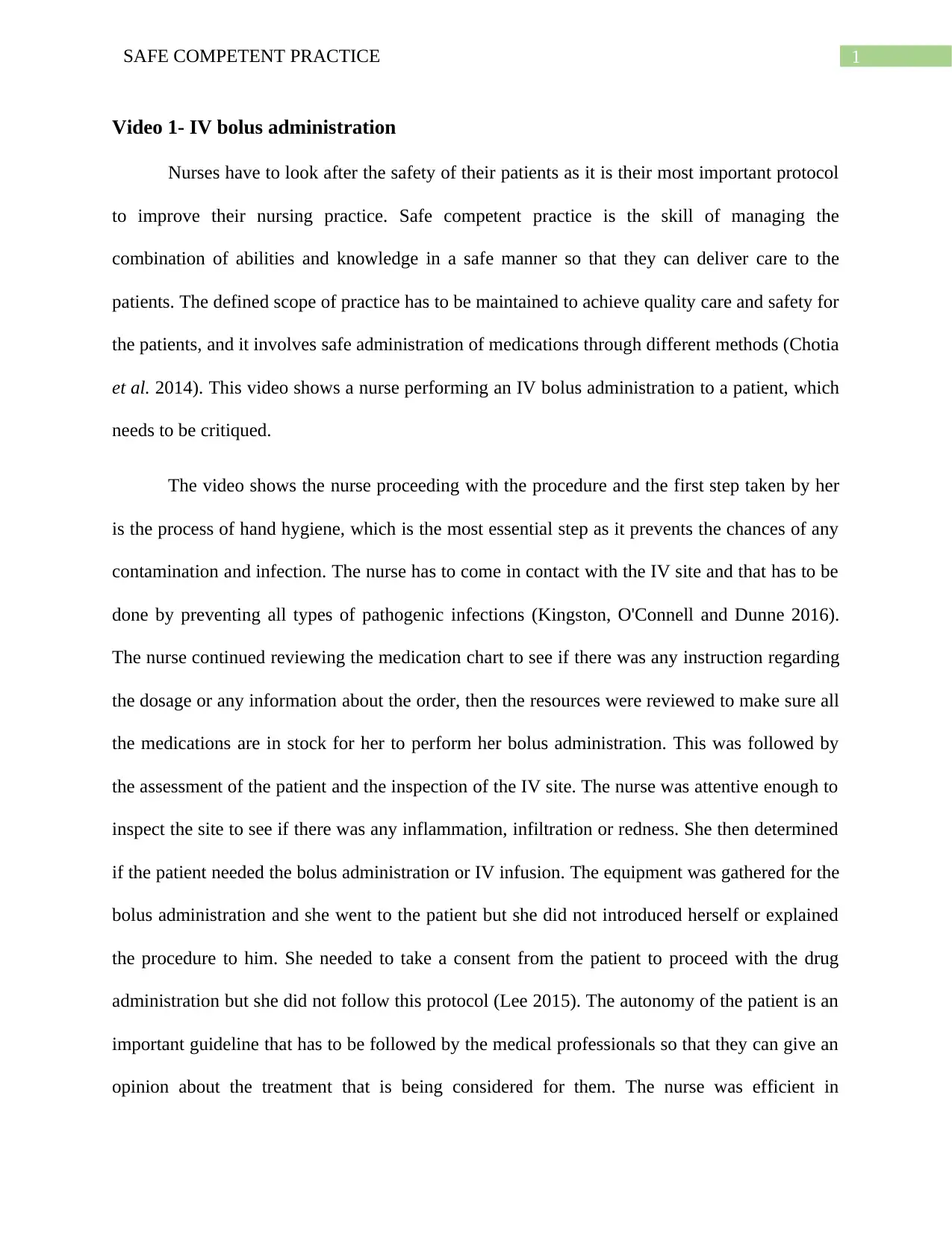
1SAFE COMPETENT PRACTICE
Video 1- IV bolus administration
Nurses have to look after the safety of their patients as it is their most important protocol
to improve their nursing practice. Safe competent practice is the skill of managing the
combination of abilities and knowledge in a safe manner so that they can deliver care to the
patients. The defined scope of practice has to be maintained to achieve quality care and safety for
the patients, and it involves safe administration of medications through different methods (Chotia
et al. 2014). This video shows a nurse performing an IV bolus administration to a patient, which
needs to be critiqued.
The video shows the nurse proceeding with the procedure and the first step taken by her
is the process of hand hygiene, which is the most essential step as it prevents the chances of any
contamination and infection. The nurse has to come in contact with the IV site and that has to be
done by preventing all types of pathogenic infections (Kingston, O'Connell and Dunne 2016).
The nurse continued reviewing the medication chart to see if there was any instruction regarding
the dosage or any information about the order, then the resources were reviewed to make sure all
the medications are in stock for her to perform her bolus administration. This was followed by
the assessment of the patient and the inspection of the IV site. The nurse was attentive enough to
inspect the site to see if there was any inflammation, infiltration or redness. She then determined
if the patient needed the bolus administration or IV infusion. The equipment was gathered for the
bolus administration and she went to the patient but she did not introduced herself or explained
the procedure to him. She needed to take a consent from the patient to proceed with the drug
administration but she did not follow this protocol (Lee 2015). The autonomy of the patient is an
important guideline that has to be followed by the medical professionals so that they can give an
opinion about the treatment that is being considered for them. The nurse was efficient in
Video 1- IV bolus administration
Nurses have to look after the safety of their patients as it is their most important protocol
to improve their nursing practice. Safe competent practice is the skill of managing the
combination of abilities and knowledge in a safe manner so that they can deliver care to the
patients. The defined scope of practice has to be maintained to achieve quality care and safety for
the patients, and it involves safe administration of medications through different methods (Chotia
et al. 2014). This video shows a nurse performing an IV bolus administration to a patient, which
needs to be critiqued.
The video shows the nurse proceeding with the procedure and the first step taken by her
is the process of hand hygiene, which is the most essential step as it prevents the chances of any
contamination and infection. The nurse has to come in contact with the IV site and that has to be
done by preventing all types of pathogenic infections (Kingston, O'Connell and Dunne 2016).
The nurse continued reviewing the medication chart to see if there was any instruction regarding
the dosage or any information about the order, then the resources were reviewed to make sure all
the medications are in stock for her to perform her bolus administration. This was followed by
the assessment of the patient and the inspection of the IV site. The nurse was attentive enough to
inspect the site to see if there was any inflammation, infiltration or redness. She then determined
if the patient needed the bolus administration or IV infusion. The equipment was gathered for the
bolus administration and she went to the patient but she did not introduced herself or explained
the procedure to him. She needed to take a consent from the patient to proceed with the drug
administration but she did not follow this protocol (Lee 2015). The autonomy of the patient is an
important guideline that has to be followed by the medical professionals so that they can give an
opinion about the treatment that is being considered for them. The nurse was efficient in
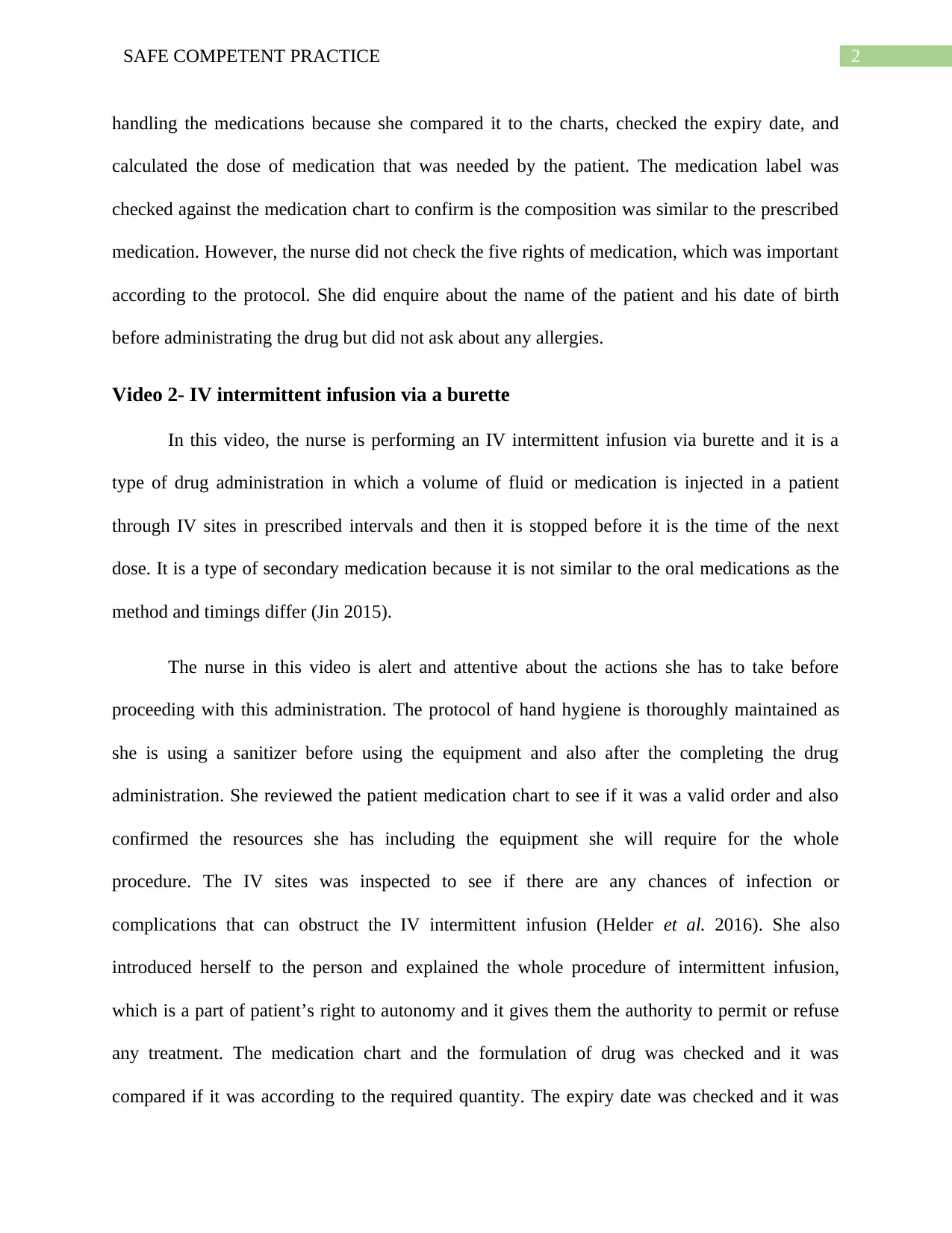
2SAFE COMPETENT PRACTICE
handling the medications because she compared it to the charts, checked the expiry date, and
calculated the dose of medication that was needed by the patient. The medication label was
checked against the medication chart to confirm is the composition was similar to the prescribed
medication. However, the nurse did not check the five rights of medication, which was important
according to the protocol. She did enquire about the name of the patient and his date of birth
before administrating the drug but did not ask about any allergies.
Video 2- IV intermittent infusion via a burette
In this video, the nurse is performing an IV intermittent infusion via burette and it is a
type of drug administration in which a volume of fluid or medication is injected in a patient
through IV sites in prescribed intervals and then it is stopped before it is the time of the next
dose. It is a type of secondary medication because it is not similar to the oral medications as the
method and timings differ (Jin 2015).
The nurse in this video is alert and attentive about the actions she has to take before
proceeding with this administration. The protocol of hand hygiene is thoroughly maintained as
she is using a sanitizer before using the equipment and also after the completing the drug
administration. She reviewed the patient medication chart to see if it was a valid order and also
confirmed the resources she has including the equipment she will require for the whole
procedure. The IV sites was inspected to see if there are any chances of infection or
complications that can obstruct the IV intermittent infusion (Helder et al. 2016). She also
introduced herself to the person and explained the whole procedure of intermittent infusion,
which is a part of patient’s right to autonomy and it gives them the authority to permit or refuse
any treatment. The medication chart and the formulation of drug was checked and it was
compared if it was according to the required quantity. The expiry date was checked and it was
handling the medications because she compared it to the charts, checked the expiry date, and
calculated the dose of medication that was needed by the patient. The medication label was
checked against the medication chart to confirm is the composition was similar to the prescribed
medication. However, the nurse did not check the five rights of medication, which was important
according to the protocol. She did enquire about the name of the patient and his date of birth
before administrating the drug but did not ask about any allergies.
Video 2- IV intermittent infusion via a burette
In this video, the nurse is performing an IV intermittent infusion via burette and it is a
type of drug administration in which a volume of fluid or medication is injected in a patient
through IV sites in prescribed intervals and then it is stopped before it is the time of the next
dose. It is a type of secondary medication because it is not similar to the oral medications as the
method and timings differ (Jin 2015).
The nurse in this video is alert and attentive about the actions she has to take before
proceeding with this administration. The protocol of hand hygiene is thoroughly maintained as
she is using a sanitizer before using the equipment and also after the completing the drug
administration. She reviewed the patient medication chart to see if it was a valid order and also
confirmed the resources she has including the equipment she will require for the whole
procedure. The IV sites was inspected to see if there are any chances of infection or
complications that can obstruct the IV intermittent infusion (Helder et al. 2016). She also
introduced herself to the person and explained the whole procedure of intermittent infusion,
which is a part of patient’s right to autonomy and it gives them the authority to permit or refuse
any treatment. The medication chart and the formulation of drug was checked and it was
compared if it was according to the required quantity. The expiry date was checked and it was
⊘ This is a preview!⊘
Do you want full access?
Subscribe today to unlock all pages.

Trusted by 1+ million students worldwide
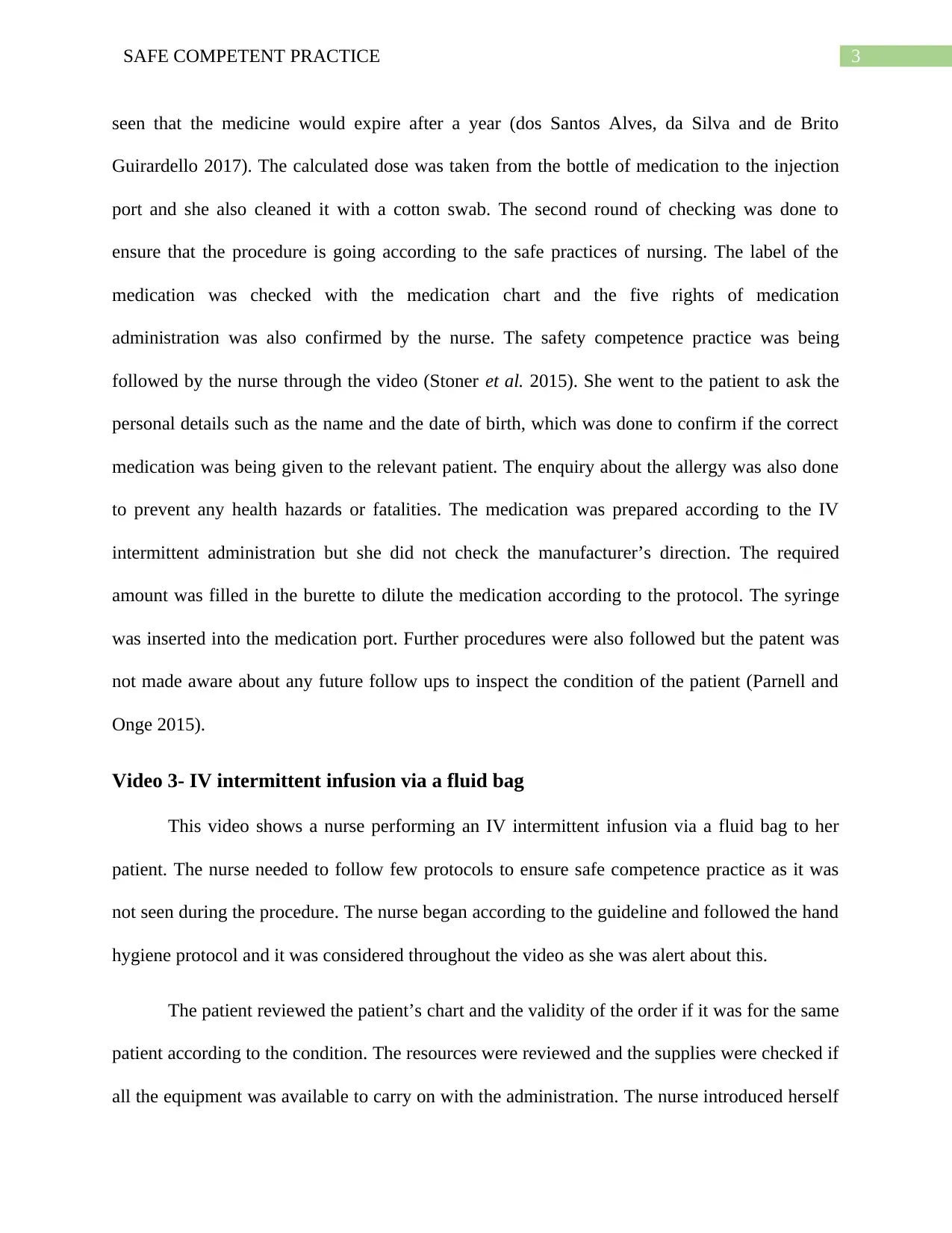
3SAFE COMPETENT PRACTICE
seen that the medicine would expire after a year (dos Santos Alves, da Silva and de Brito
Guirardello 2017). The calculated dose was taken from the bottle of medication to the injection
port and she also cleaned it with a cotton swab. The second round of checking was done to
ensure that the procedure is going according to the safe practices of nursing. The label of the
medication was checked with the medication chart and the five rights of medication
administration was also confirmed by the nurse. The safety competence practice was being
followed by the nurse through the video (Stoner et al. 2015). She went to the patient to ask the
personal details such as the name and the date of birth, which was done to confirm if the correct
medication was being given to the relevant patient. The enquiry about the allergy was also done
to prevent any health hazards or fatalities. The medication was prepared according to the IV
intermittent administration but she did not check the manufacturer’s direction. The required
amount was filled in the burette to dilute the medication according to the protocol. The syringe
was inserted into the medication port. Further procedures were also followed but the patent was
not made aware about any future follow ups to inspect the condition of the patient (Parnell and
Onge 2015).
Video 3- IV intermittent infusion via a fluid bag
This video shows a nurse performing an IV intermittent infusion via a fluid bag to her
patient. The nurse needed to follow few protocols to ensure safe competence practice as it was
not seen during the procedure. The nurse began according to the guideline and followed the hand
hygiene protocol and it was considered throughout the video as she was alert about this.
The patient reviewed the patient’s chart and the validity of the order if it was for the same
patient according to the condition. The resources were reviewed and the supplies were checked if
all the equipment was available to carry on with the administration. The nurse introduced herself
seen that the medicine would expire after a year (dos Santos Alves, da Silva and de Brito
Guirardello 2017). The calculated dose was taken from the bottle of medication to the injection
port and she also cleaned it with a cotton swab. The second round of checking was done to
ensure that the procedure is going according to the safe practices of nursing. The label of the
medication was checked with the medication chart and the five rights of medication
administration was also confirmed by the nurse. The safety competence practice was being
followed by the nurse through the video (Stoner et al. 2015). She went to the patient to ask the
personal details such as the name and the date of birth, which was done to confirm if the correct
medication was being given to the relevant patient. The enquiry about the allergy was also done
to prevent any health hazards or fatalities. The medication was prepared according to the IV
intermittent administration but she did not check the manufacturer’s direction. The required
amount was filled in the burette to dilute the medication according to the protocol. The syringe
was inserted into the medication port. Further procedures were also followed but the patent was
not made aware about any future follow ups to inspect the condition of the patient (Parnell and
Onge 2015).
Video 3- IV intermittent infusion via a fluid bag
This video shows a nurse performing an IV intermittent infusion via a fluid bag to her
patient. The nurse needed to follow few protocols to ensure safe competence practice as it was
not seen during the procedure. The nurse began according to the guideline and followed the hand
hygiene protocol and it was considered throughout the video as she was alert about this.
The patient reviewed the patient’s chart and the validity of the order if it was for the same
patient according to the condition. The resources were reviewed and the supplies were checked if
all the equipment was available to carry on with the administration. The nurse introduced herself
Paraphrase This Document
Need a fresh take? Get an instant paraphrase of this document with our AI Paraphraser
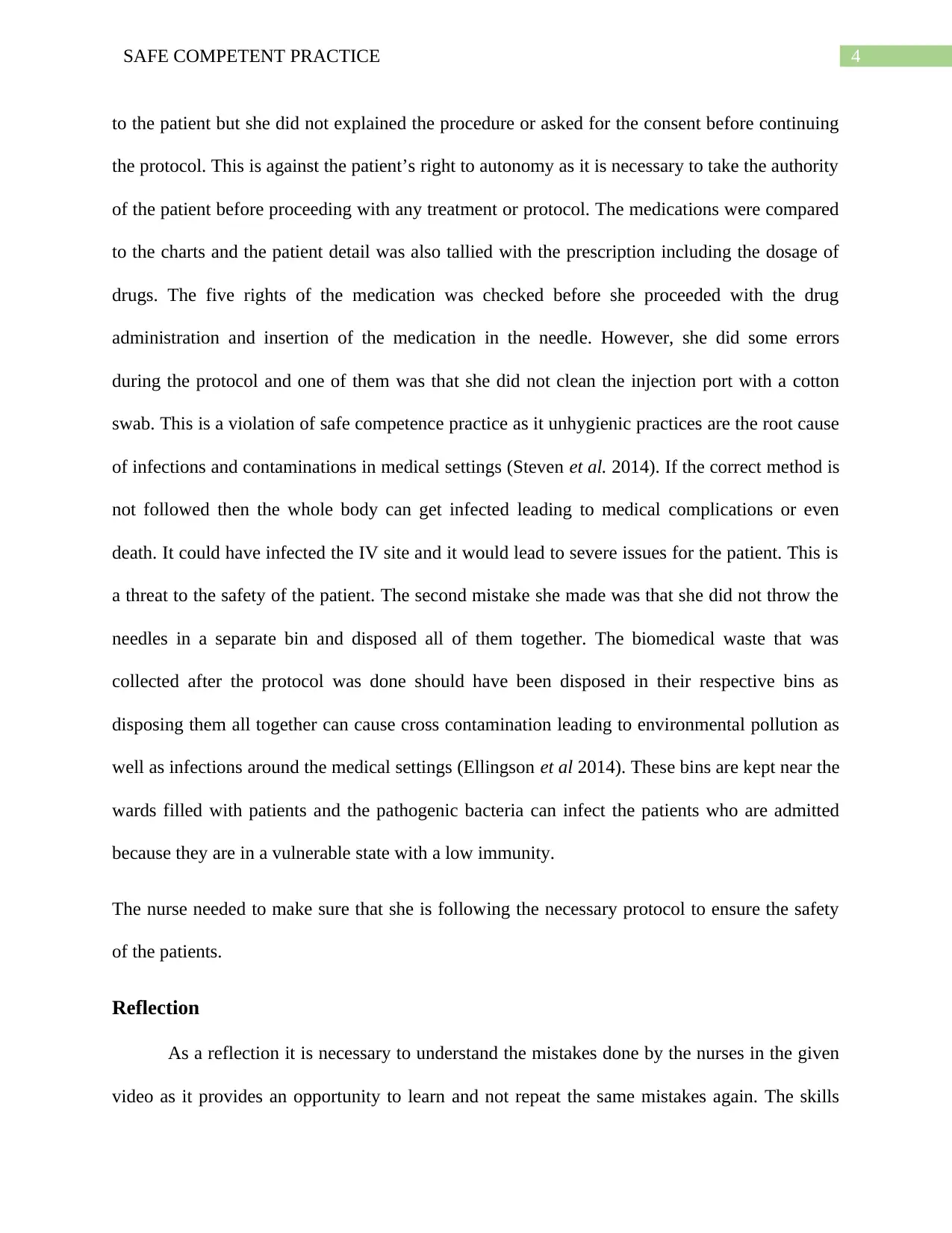
4SAFE COMPETENT PRACTICE
to the patient but she did not explained the procedure or asked for the consent before continuing
the protocol. This is against the patient’s right to autonomy as it is necessary to take the authority
of the patient before proceeding with any treatment or protocol. The medications were compared
to the charts and the patient detail was also tallied with the prescription including the dosage of
drugs. The five rights of the medication was checked before she proceeded with the drug
administration and insertion of the medication in the needle. However, she did some errors
during the protocol and one of them was that she did not clean the injection port with a cotton
swab. This is a violation of safe competence practice as it unhygienic practices are the root cause
of infections and contaminations in medical settings (Steven et al. 2014). If the correct method is
not followed then the whole body can get infected leading to medical complications or even
death. It could have infected the IV site and it would lead to severe issues for the patient. This is
a threat to the safety of the patient. The second mistake she made was that she did not throw the
needles in a separate bin and disposed all of them together. The biomedical waste that was
collected after the protocol was done should have been disposed in their respective bins as
disposing them all together can cause cross contamination leading to environmental pollution as
well as infections around the medical settings (Ellingson et al 2014). These bins are kept near the
wards filled with patients and the pathogenic bacteria can infect the patients who are admitted
because they are in a vulnerable state with a low immunity.
The nurse needed to make sure that she is following the necessary protocol to ensure the safety
of the patients.
Reflection
As a reflection it is necessary to understand the mistakes done by the nurses in the given
video as it provides an opportunity to learn and not repeat the same mistakes again. The skills
to the patient but she did not explained the procedure or asked for the consent before continuing
the protocol. This is against the patient’s right to autonomy as it is necessary to take the authority
of the patient before proceeding with any treatment or protocol. The medications were compared
to the charts and the patient detail was also tallied with the prescription including the dosage of
drugs. The five rights of the medication was checked before she proceeded with the drug
administration and insertion of the medication in the needle. However, she did some errors
during the protocol and one of them was that she did not clean the injection port with a cotton
swab. This is a violation of safe competence practice as it unhygienic practices are the root cause
of infections and contaminations in medical settings (Steven et al. 2014). If the correct method is
not followed then the whole body can get infected leading to medical complications or even
death. It could have infected the IV site and it would lead to severe issues for the patient. This is
a threat to the safety of the patient. The second mistake she made was that she did not throw the
needles in a separate bin and disposed all of them together. The biomedical waste that was
collected after the protocol was done should have been disposed in their respective bins as
disposing them all together can cause cross contamination leading to environmental pollution as
well as infections around the medical settings (Ellingson et al 2014). These bins are kept near the
wards filled with patients and the pathogenic bacteria can infect the patients who are admitted
because they are in a vulnerable state with a low immunity.
The nurse needed to make sure that she is following the necessary protocol to ensure the safety
of the patients.
Reflection
As a reflection it is necessary to understand the mistakes done by the nurses in the given
video as it provides an opportunity to learn and not repeat the same mistakes again. The skills

5SAFE COMPETENT PRACTICE
demonstrated in the videos were IV administration of drugs, which is the intravenous method
and it uses syringes and injections that needs precision. The areas of weakness were the hygiene
factor for few nurses as they were not attentive about the cleanliness and disposal techniques,
which is essential for a nurse to follow (Mahida et al. 2015). The practice of registered nurses
have to be in sync with the safety and quality care of patients and it should be a prioritized goal.
The plan of activities to meet the identified goals include following the protocol of
hygiene in a medical setting according to the demands of the organization and I will also learn
the segregation of biomedical waste so that the waste is not a root cause of contamination in a
healthcare industry. The cleaning of all kinds of injection ports and syringes are necessary for a
safe competence practice as the safety of the patient should not be at risk (Blignant et al. 2017).
demonstrated in the videos were IV administration of drugs, which is the intravenous method
and it uses syringes and injections that needs precision. The areas of weakness were the hygiene
factor for few nurses as they were not attentive about the cleanliness and disposal techniques,
which is essential for a nurse to follow (Mahida et al. 2015). The practice of registered nurses
have to be in sync with the safety and quality care of patients and it should be a prioritized goal.
The plan of activities to meet the identified goals include following the protocol of
hygiene in a medical setting according to the demands of the organization and I will also learn
the segregation of biomedical waste so that the waste is not a root cause of contamination in a
healthcare industry. The cleaning of all kinds of injection ports and syringes are necessary for a
safe competence practice as the safety of the patient should not be at risk (Blignant et al. 2017).
⊘ This is a preview!⊘
Do you want full access?
Subscribe today to unlock all pages.

Trusted by 1+ million students worldwide

6SAFE COMPETENT PRACTICE
References
Blignaut, A.J., Coetzee, S.K., Klopper, H.C. and Ellis, S.M., 2017. Medication administration
errors and related deviations from safe practice: an observational study. Journal of clinical
nursing, 26(21-22), pp.3610-3623.
Chothia, M.Y., Halperin, M.L., Rensburg, M.A., Hassan, M.S. and Davids, M.R., 2014. Bolus
administration of intravenous glucose in the treatment of hyperkalemia: a randomized controlled
trial. Nephron Physiology, 126(1), pp.1-8.
dos Santos Alves, D.F., da Silva, D. and de Brito Guirardello, E., 2017. Nursing practice
environment, job outcomes and safety climate: a structural equation modelling analysis. Journal
of nursing management, 25(1), pp.46-55.
Ellingson, K., Haas, J.P., Aiello, A.E., Kusek, L., Maragakis, L.L., Olmsted, R.N., Perencevich,
E., Polgreen, P.M., Schweizer, M.L., Trexler, P. and VanAmringe, M., 2014. Strategies to
prevent healthcare-associated infections through hand hygiene. Infection Control & Hospital
Epidemiology, 35(8), pp.937-960.
Helder, O.K., Kornelisse, R.F., Reiss, I.K. and Ista, E., 2016. Disinfection practices in
intravenous drug administration. American journal of infection control, 44(6), pp.721-723.
Jin, J.F., Zhu, L.L., Chen, M., Xu, H.M., Wang, H.F., Feng, X.Q., Zhu, X.P. and Zhou, Q., 2015.
The optimal choice of medication administration route regarding intravenous, intramuscular, and
subcutaneous injection. Patient preference and adherence, 9, p.923.
Kingston, L., O'Connell, N.H. and Dunne, C.P., 2016. Hand hygiene-related clinical trials
reported since 2010: a systematic review. Journal of Hospital Infection, 92(4), pp.309-320.
References
Blignaut, A.J., Coetzee, S.K., Klopper, H.C. and Ellis, S.M., 2017. Medication administration
errors and related deviations from safe practice: an observational study. Journal of clinical
nursing, 26(21-22), pp.3610-3623.
Chothia, M.Y., Halperin, M.L., Rensburg, M.A., Hassan, M.S. and Davids, M.R., 2014. Bolus
administration of intravenous glucose in the treatment of hyperkalemia: a randomized controlled
trial. Nephron Physiology, 126(1), pp.1-8.
dos Santos Alves, D.F., da Silva, D. and de Brito Guirardello, E., 2017. Nursing practice
environment, job outcomes and safety climate: a structural equation modelling analysis. Journal
of nursing management, 25(1), pp.46-55.
Ellingson, K., Haas, J.P., Aiello, A.E., Kusek, L., Maragakis, L.L., Olmsted, R.N., Perencevich,
E., Polgreen, P.M., Schweizer, M.L., Trexler, P. and VanAmringe, M., 2014. Strategies to
prevent healthcare-associated infections through hand hygiene. Infection Control & Hospital
Epidemiology, 35(8), pp.937-960.
Helder, O.K., Kornelisse, R.F., Reiss, I.K. and Ista, E., 2016. Disinfection practices in
intravenous drug administration. American journal of infection control, 44(6), pp.721-723.
Jin, J.F., Zhu, L.L., Chen, M., Xu, H.M., Wang, H.F., Feng, X.Q., Zhu, X.P. and Zhou, Q., 2015.
The optimal choice of medication administration route regarding intravenous, intramuscular, and
subcutaneous injection. Patient preference and adherence, 9, p.923.
Kingston, L., O'Connell, N.H. and Dunne, C.P., 2016. Hand hygiene-related clinical trials
reported since 2010: a systematic review. Journal of Hospital Infection, 92(4), pp.309-320.
Paraphrase This Document
Need a fresh take? Get an instant paraphrase of this document with our AI Paraphraser

7SAFE COMPETENT PRACTICE
Lee, P., 2015. IV administration: making a decision. British Journal of Healthcare Management.
Mahida, N., Levi, K., Kearns, A., Snape, S. and Moppett, I., 2015. Investigating the impact of
clinical anaesthetic practice on bacterial contamination of intravenous fluids and drugs. Journal
of Hospital Infection, 90(1), pp.70-74.
Parnell, R.B. and Onge, J.L.S., 2015. Teaching safety in nursing practice: Is emotional
intelligence a vital component?. Teaching and Learning in Nursing, 10(2), pp.88-92.
Steven, A., Magnusson, C., Smith, P. and Pearson, P.H., 2014. Patient safety in nursing
education: contexts, tensions and feeling safe to learn. Nurse education today, 34(2), pp.277-284.
Stoner, K.L., Harder, H., Fallowfield, L.J. and Jenkins, V.A., 2015. Intravenous versus
subcutaneous drug administration. Which do patients prefer? A systematic review. The Patient-
Patient-Centered Outcomes Research, 8(2), pp.145-153.
Lee, P., 2015. IV administration: making a decision. British Journal of Healthcare Management.
Mahida, N., Levi, K., Kearns, A., Snape, S. and Moppett, I., 2015. Investigating the impact of
clinical anaesthetic practice on bacterial contamination of intravenous fluids and drugs. Journal
of Hospital Infection, 90(1), pp.70-74.
Parnell, R.B. and Onge, J.L.S., 2015. Teaching safety in nursing practice: Is emotional
intelligence a vital component?. Teaching and Learning in Nursing, 10(2), pp.88-92.
Steven, A., Magnusson, C., Smith, P. and Pearson, P.H., 2014. Patient safety in nursing
education: contexts, tensions and feeling safe to learn. Nurse education today, 34(2), pp.277-284.
Stoner, K.L., Harder, H., Fallowfield, L.J. and Jenkins, V.A., 2015. Intravenous versus
subcutaneous drug administration. Which do patients prefer? A systematic review. The Patient-
Patient-Centered Outcomes Research, 8(2), pp.145-153.
1 out of 8
Related Documents
Your All-in-One AI-Powered Toolkit for Academic Success.
+13062052269
info@desklib.com
Available 24*7 on WhatsApp / Email
![[object Object]](/_next/static/media/star-bottom.7253800d.svg)
Unlock your academic potential
Copyright © 2020–2025 A2Z Services. All Rights Reserved. Developed and managed by ZUCOL.





